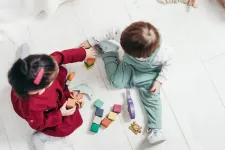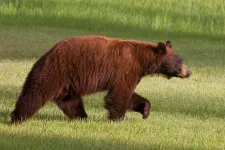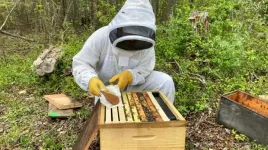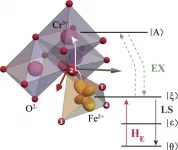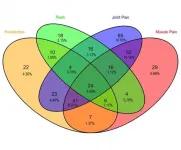Reef-building corals and the microscopic algae within their cells evolve together
Genetics of coral-algal partnerships may have conservation implications
2021-05-28
(Press-News.org) UNIVERSITY PARK, Pa. -- The microscopic algae that live inside and provide nutrients to their reef-building coral hosts may be evolving in tandem with the corals they inhabit, so each partner is fine-tuned to meet one another's needs. A new study by Penn State biologists reveals that genetic differences within a species of these microalgal symbionts correspond to the coral species they inhabit, a discovery that could have implications for the conservation of these endangered corals.
"Acroporid corals are some of the primary reef-building species in the Caribbean, providing protection to coastlines and habitat for economically important species," said Iliana Baums, professor of biology at Penn State and leader of the research team. "However, these corals are critically endangered due to warming waters, pollution, and other human-induced changes, and their survival is in part tied to the symbionts that live inside them. Understanding the relationships between the coral and their symbionts may help us improve conservation efforts."
Reef-building corals such as Acroporids obtain nutrients from the microalgae symbionts that live inside their cells. The research team compared genetic differences among members of the symbiont species Symbiodinium 'fitti' collected from either elkhorn coral (Acropora palmata), the closely related staghorn coral (Acropora cervicornis), or the hybrid that results when the two species breed, called fused staghorn coral. The researchers collected symbiont samples from each coral species in several locations spanning the Caribbean Sea. Their results appear online in the journal Molecular Ecology.
"The genetic differences we saw within the symbiont were primarily explained by the species of host we collected them from," said Hannah Reich, a graduate student at Penn State at the time of the research and currently a postdoctoral researcher at the University of Rhode Island. "Each coral species is a unique micro-habitat for their symbionts. For example, the limestone skeletons of the two coral species are distinct and reflect sunlight differently. So the symbionts must adapt to the conditions created by each host to best harness solar energy and convert it to food. They then provide this nourishment to their hosts which rely on it for most of their nutrition."
The researchers suspect that each of the coral species has coevolved with a subset of the strains of S. 'fitti'. Over generations, they have formed more specialized relationships. This specialization even occurred in the natural coral hybrid that has a relatively recent origin.
"Some of the genetic differences we observed among S. 'fitti' strains were in genes predicted to cause downstream effects on the symbiont's metabolism and physiology," said Sheila Kitchen, a postdoctoral researcher at Penn State at the time of the research and currently a postdoctoral researcher at the California Institute of Technology. "These changes may enable the symbiont to adapt to the unique metabolic and nutritional demands imposed by each host's microenvironment."
The fidelity between the coral species and their symbionts could be reinforced if symbionts are selective about which coral species they colonize, and/or if the coral hosts are selective about which symbiont strain is allowed to remain in their cells, though the mechanisms of partner selectivity remain unclear. The researchers note that environmental factors may also play a role in genetic differences among the symbiont strains, for example by influencing the symbionts before they have colonized a coral or indirectly by influencing the microenvironment inside the coral host.
"Some conservation efforts are exploring ways to help corals colonize new habitats and adapt to changing environments," said Reich. "However, if symbionts and their corals hosts have coevolved and formed preferential relationships with each other, it may not be enough to focus conservation efforts just on the coral host. Continuing to study these relationships will provide important information about how we can best approach conservation efforts."
INFORMATION:
In addition to Baums, Reich, and Kitchen, the research team at Penn State includes Kathryn Stankiewicz, graduate student in biology, and Meghann Devlin-Durante, senior research technologist at the time of the research. The team also includes Nicole Fogarty at the University of North Carolina, Wilmington. This work was supported by the National Science Foundation.
[Attachments] See images for this press release:

ELSE PRESS RELEASES FROM THIS DATE:
2021-05-28
A study examining Japanese schools' hands-off approach when children fight showed it could create opportunities for autonomy and encourage ownership of solutions, suggesting a new strategy in handling kids squabbles in other countries.
Called mimamoru, the pedagogical strategy is a portmanteau of the Japanese words mi, meaning watch, and mamoru, meaning guard or protect. It is generally understood as "teaching by watching" -- where adults, including early childhood educators, intentionally let kids handle disagreements on their own to promote their learning through voluntary exploration and actions. While not an official part of Japan's early childhood ...
2021-05-28
While DNA is often idealised as the "molecule of life", it is also a highly sophisticated polymer that can be used for next-generation materials. Beyond the fact that it can store information, further fascinating aspects of DNA are its geometric and topological properties, such as knotting and super-coiling. Indeed, very much like a twisted telephone cord, DNA is often found coiled up inside bacteria and other cells and even knotted in viruses. Now, a collaboration of scientists from the Universities of Edinburgh, San Diego and Vienna have started to harness these properties to craft "topologically ...
2021-05-28
MISSOULA - In bear country, it's normal to find bruins munching down on temptations left out by humans - from a backyard apple tree to leftovers in the trash bin - but these encounters can cause trouble for humans and bears alike. One method to reduce human-bear conflicts is to secure attractants like garbage and livestock feed.
While effective when implemented, this approach requires people to change their behavior, and that makes things a little more complicated.
University of Montana researchers recently published a new study in the Journal of Wildlife Management analyzing why landowners do or don't secure attractants in bear country. ...
2021-05-28
Ishikawa, Japan - Protons--subatomic particles with a positive electric charge--are one of the first particles to have formed after the universe began and are a constituent of every atom today out there. The movement of protons plays a key role in energy conversion processes, such as photosynthesis and respiration, in biological systems. In addition, proton conduction is an important factor for hydrogen fuel cells, which are often touted as the ideal clean energy source for the next generation.
High proton conduction observed in biomaterials such as sugar and protein derivatives is attributed to the presence of proton-donating functional groups (substituents in a molecule that governs its characteristic ...
2021-05-28
ITHACA, N.Y. - A Cornell University-developed technology provides beekeepers, consumers and farmers with an antidote for deadly pesticides, which kill wild bees and cause beekeepers to lose around a third of their hives every year on average.
An early version of the technology ¬- which detoxified a widely-used group of insecticides called organophosphates - is described in a new study, "Pollen-Inspired Enzymatic Microparticles to Reduce Organophosphate Toxicity in Managed Pollinators," published in Nature Food. The antidote delivery method has now been adapted to effectively ...
2021-05-28
The authors, Kirill Vasin and Mikhail Eremin, contribute to the theory of electronic and structural properties of FeCr2O4 ferrimagnet. Due to the specific quantum state and the symmetry of FeO4 fragment, it has unusual electric and magnetic properties. Below TOO~150K, it lowers the symmetry with the macroscopic deformations due to the cooperative Jahn-Teller effect. The coupling between macroscopic deformation of the crystal FeCr2O4 and its inner ions shifts was revealed. The team enhanced the microscopic crystal field theory for 3D electrons with Kleiner's correction - the effect of penetrating charges density. It allows to have better prediction of electron-deformation ...
2021-05-28
In a paper published in NANO, the author reviewed many kinds of nanofibrous filters including the component, preparation process, and application performances to provide directional guidance for improvement of the air purification field.
Poor air quality is worldwide recognized as one of five health risks for causing adverse impacts on human health. Nanofibrous membrane is competitive to capture unclean nanoparticles since its lightweight, small diameter, high specific surface area, and easy to combine with functional additives. However, the trade-off between high filtration efficiency and low pressure drop posts challenge.
The removal mechanisms of fibrous filters to nanoparticles follow ...
2021-05-28
How to construct the dual emission nitrogen-doped carbon dots (CDs) by a simple method? Professor Lili Ren with her collaborators proposed a new strategy to prepare such materials which were used to the detection of dopamine.
The traditional ratiometric fluorescence (FL) probe usually needs to combine different nanomaterials by chemical or physical methods and the manufacturing process is more complicated. While the dual-emission carbon dots (DECDs) can simplify the detection process. Therefore, it is of great significance to design a simple ratiometric fluorescence probe based on the DECDs for the accurate determination of DA concentration. ...
2021-05-28
Singapore University of Technology and Design (SUTD) researchers have uncovered how the environment can impact highly sensitive quantum behaviours like localisation. Their findings, published in Chaos, could lead to future innovations in the design of superconducting materials and quantum devices, including super precise sensors.
Quantum technology, in particular quantum sensing, promises to measure and capture our world at levels of precision never before possible. Such precision has diverse applications, from speedier and more sensitive medical imaging to recording time on high-frequency ...
2021-05-28
In the Philippines, in the early months of the COVID-19 pandemic, there occurred a supply shortage of hydroxychloroquine and methotrexate. Limited access to medication and the life changes caused from the COVID-19 pandemic may prompt patients with rheumatoid arthritis (RA) or systemic lupus erythematosus (SLE) to experience disease flares.
The researchers investigated self-reported symptoms of disease flares among patients with rheumatoid arthritis or systemic lupus erythematosus during the COVID-19 pandemic. They collected information through online surveys from 512 patients with SLE or RA. The data included ...
LAST 30 PRESS RELEASES:
[Press-News.org] Reef-building corals and the microscopic algae within their cells evolve together
Genetics of coral-algal partnerships may have conservation implications

